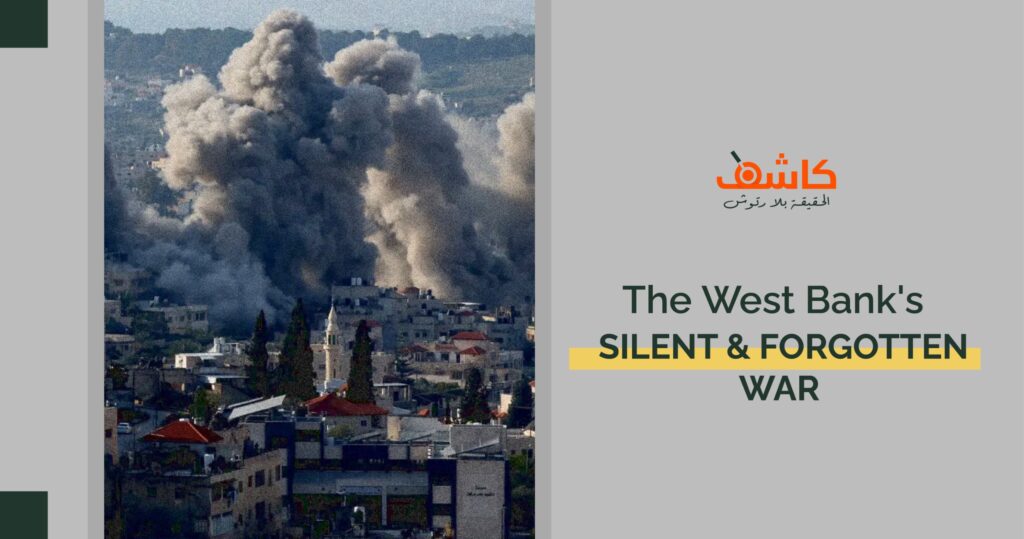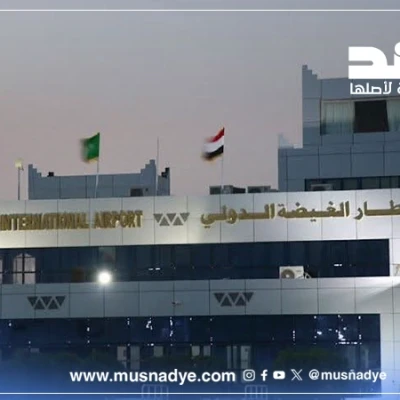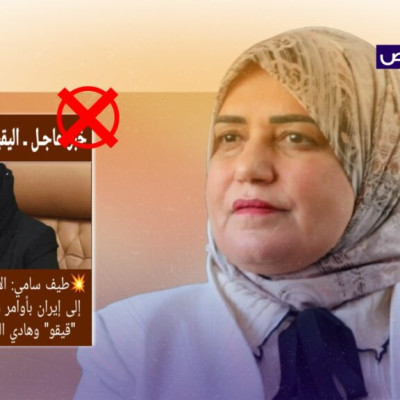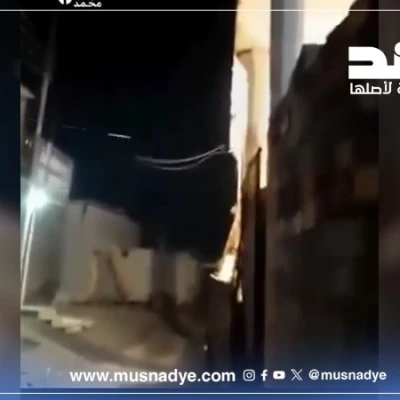A Few Kilometers Away from Gaza: A Silent and Forgotten War in West Bank

Since the 7th October 2023, the genocide wasn’t only happening in Gaza, but in the West Bank too, a wide scale escalation, described by human rights organizations as the most dangerous wave of repression and settlement expansion since the second Intifada. Since then, the Israeli occupation forces reinforced their military presence in the West Bank governorates, deployed special forces, and erected thousands of checkpoints and barrier gates between cities, towns, and refugee camps, turning the West Bank into isolated and besieged areas internally. These checkpoints weren’t only security points, but a strategic and systematic tool to ensure control over Palestinians’ movement, and obstruct their economic and social life.
Over this time, the West Bank has witnessed a wave of unprecedented violence and killings against Palestinians. According to the Palestinian Central Bureau of Statistics, 1066 Palestinians have been killed in the West Bank in the period between 7th October 2023 to 12 November 2025, and 10,000 wounded by the Israeli occupation forces and illegal settlers.
Human Rights Watch reported that in May 2024, the number of Palestinians killed by the Israeli forces has doubled compared to any other years since systematic documentation began in 2005.
On the other hand of this silent war, administrative detention has become a collective policy; a joint 7th October 2025 report by the Palestinian Prisoners Club, al-Dameer Foundation, and the Prisoners’ Affairs Commission of the PLO, stated that the Israeli army arrested more than 20,000 Palestinians from the West Bank and East Jerusalem, many of whom were subjected to extreme psychological and physical torture during integrations and in detention centers, in violation of the Geneva convention and humanitarian international law.
These figures show that the West Bank has become a parallel battle ground to the Gaza Strip, where systematic operations of killing, arrest, confiscation, and displacement are being carried out. While headlines have remained focused on Gaza, the reality in the West Bank reveals a silent and forgotten war, happening on a daily basis under the cover of “security” and the support of the growing settlement infrastructure.
1.Land Seizure and settlement expansion
Since 7th October 2023, the West Bank has witnessed an unprecedented wave of land seizure and confiscation and settlement expansion, described as the largest since the Oslo agreement in 1993. The Israeli occupation confiscated over 52,000 dunams of citizens lands in the West Bank, 46,000 of which during 2024.
On 4 July 2024, the Israeli occupation government approved a decision designating approximately 12.7 square kilometers of land in the northern Jordan Valley as “state land.” This area is more than three times the total land seized in previous years combined. The Israeli anti-settlement organization Peace Now stated that this decision constitutes the largest land seizure since the signing of the Oslo Accords, noting that it is part of a broader policy aimed at transforming agricultural and pastoral areas in the Jordan Valley into closed settlement zones and preventing Palestinians from accessing them.
This decision was not isolated; rather, it paved the way for a new phase of organized expansion in 2025. On 30 May 30, 2025, the Israeli occupation government approved a massive settlement construction package in West Bank settlements, described as the largest since the 1990s in terms of the number of plans and simultaneous approvals. The package includes more than 7,000 new settlement units distributed across Bethlehem, Jerusalem, Hebron, and Nablus, part of a strategy to engineer demographic and geographic changes that would fragment the West Bank into isolated cantons.
2) Settler Attacks: Record Levels
Alongside land seizures, attacks by armed settlers on Palestinian villages rose at an unprecedented rate. Since the beginning of 2025, settlers have carried out more than 2,153 attacks on Palestinians, their property, and their land. October 2025 alone witnessed 264 attacks, the highest monthly number documented by the United Nations since monitoring began in 2006, an average of eight attacks per day.
Settler attacks in 2024 exceeded 2,971, while 2023 saw 2,410 attacks. These included arson of homes and vehicles, uprooting of olive trees, and direct gunfire. Reports by the UN Office for the Coordination of Humanitarian Affairs (OCHA) indicate that most of these attacks occurred with the protection or direct support of the Israeli military, particularly around Nablus, Tulkarm, and Jenin.
3) The Largest Internal Displacement Since 1967
Amid intensified military raids and settler attacks, the West Bank witnessed its largest wave of internal displacement since 1967. Reports by UNRWA and UNOCHA–OPT confirm that by September 2025, no fewer than 31,919 Palestinians had been displaced from the Jenin, Tulkarm, and Nur Shams refugee camps, most following destructive and repeated raids by the Israeli military.
The United Nations described this as the largest displacement crisis in the West Bank since the Naksa, noting that schools and mosques have been converted into temporary shelters.
4) Widespread Destruction in Jenin, Tulkarm, and Nur Shams Camps
The refugee camps in northern West Bank, particularly Jenin, Tulkarm, and Nur Shams, became symbols of widespread destruction in 2025. According to an OCHA report issued on 24 July 2025:
43% of Jenin Camp.
35% of Nur Shams Camp.
14% of Tulkarm Camp
were damaged to varying degrees due to repeated Israeli military operations, which included the use of heavy bulldozers and airstrikes.
OCHA documented the demolition of 1,787 structures, including 800 inhabited homes, between 7 October 2023 and 7 October 2024, displacing more than 4,000 people. Between January and April 2025, OCHA recorded the demolition of an additional 465 structures under the pretext of lacking permits, displacing 445 people, as well as the punitive demolition of 11 homes belonging to families of suspected militants, and the forced expulsion of 65 individuals.
In June 2025 alone, OCHA documented the demolition of more than 20 buildings in the Jenin, Tulkarm, and Nur Shams camps, in addition to 120 buildings demolished in these same camps since the start of the military operation in January 2025.
OCHA estimated that the total number of structures demolished by Israel in the West Bank since the beginning of the war on Gaza ranges between 2,400 and 2,500.
5) Restricting and Deregistering International Organizations
In 2025, the Israeli occupation government introduced measures described as the most restrictive in two decades for international humanitarian organizations operating in the Palestinian territories. In March 2025, Israel enacted a new regulation requiring foreign organizations in the West Bank and Gaza to submit detailed financial and security information about their staff and local partners, under threat of license revocation or deregistration.
In June 2025, Haaretz revealed that Israel had suspended or reviewed the licenses of several European and international organizations, including Oxfam and Doctors of the World. The Washington Post described these measures as “part of a broader plan to restructure international activity in the West Bank in line with annexation goals.”
6) Targeting UNRWA and Revoking Its Legitimacy in Jerusalem
On 26 January 2025, Israel sent a formal notice to the United Nations instructing UNRWA to vacate all its headquarters in occupied East Jerusalem within 72 hours and halt its administrative operations in the city. UNRWA confirmed in an official statement that the move amounted to the effective shutdown of its operations in Jerusalem, aimed at stripping the agency of its legal status as a UN body operating under a General Assembly mandate.
The move followed a series of Israeli allegations against UNRWA staff in relation to the war in Gaza, which the UN rejected, describing the investigations as “politically motivated and unsupported by evidence.” The UN High Commissioner for Human Rights described the measure as a dangerous precedent that criminalizes humanitarian work, stressing that depriving refugees of UNRWA’s services worsens their living and educational conditions.
7) Movement Restrictions: The Most Extensive Since the 1990s
From the period preceding the war through 2025, the West Bank saw a sharp rise in the number of barriers and movement restrictions imposed by the Israeli military, turning daily movement into a difficult, heavily controlled process. According to OCHA:
At the beginning of 2023, there were 565 movement obstacles.
After 7 October 2023, the number surged to 793 between October 2023 and March 2024 (OCHA report, September 2024).
By May 2025, OCHA documented 849 obstacles, including permanent and partial checkpoints, roadblocks, gates, and earth mounds. These included 288 road gates that are frequently closed and 94 permanent checkpoints operating around the clock.
OCHA reported that travel delays on key routes doubled by 120% compared to 2022, and that around 60% of West Bank residents face direct movement restrictions through closures, inspections, or forced detours.
The situation was described as the “largest system of movement obstacles since the 1990s,” aimed not only at preventing armed attacks but at reshaping the social geography of the West Bank and severing connections between major cities and rural areas.
8) Arrests, Administrative Detention, and Raids
Arrests surged in 2025 to levels not seen since the Second Intifada.
According to the Prisoners’ Affairs Commission, the Palestinian Prisoners’ Society, and Addameer, between 580 and 660 people were arrested monthly during the first half of 2025. A joint fact sheet issued on October 7, 2025 states that total arrests over the past two years exceeded 20,000, mostly in Jenin, Tulkarm, Nablus, and East Jerusalem.
Administrative detention, detention without charge or trial, reached 3,563 detainees by mid-2025, the highest figure in more than two decades, before stabilizing at around 3,368 in November.
Other kashif_ps










